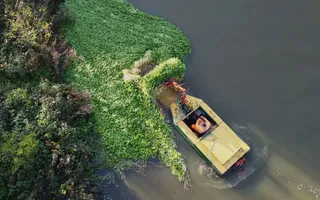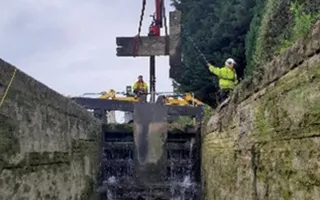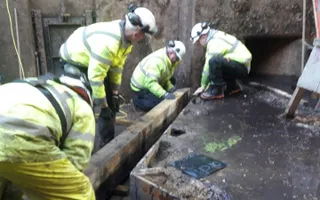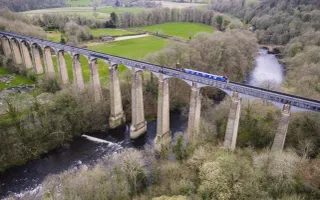Welcome to Boaters’ Update.
Boaters' Update 4 Oct 2024
Latest edition covers work to keep navigations open, Annual Report & Accounts, good and bad plastic. Oh, and Bill Bailey!

In this edition you'll find:
- Working for boaters
- Helping boaters over Hollowforth
- Warm and wet = weeds
- Dawn at the Deep
- Working for boaters – in numbers
- Annual Report & Accounts show record spending and increasing costs
- Maintenance, repair and restoration work this weekend
- Bad plastic – our Plastics Challenge
- Good plastic – coming to a canal new you
- Last opportunity to get free tickets
Hope you get afloat this weekend,
Damian
Working for boaters
The waterways have a bit of a Goldilocks syndrome – we all know what happens when we don’t get enough rain but, equally, too much can cause problems too. It’s no surprise then that September, with many places receiving three times the usual monthly amount of rain, brought challenges for the teams around the network carrying out work to keep navigations open.
As example, here’s a couple of photos from the Oxford Canal during the last week of September (and that’s before another few days of persistent rain!).


Flooding late September 2024 (2)
While the recent deluges have, in some cases, meant diverting resources to deal with the damaging effects, we’ve still been able to get a lot done to keep navigations open before, and during, the exceptionally wet spell.

Helping boaters over Hollowforth
A monumental effort, including construction of a three-sided dam, by the local team has enabled boaters on the Lancaster Canal to navigate across Hollowforth Aqueduct following a breach at the aqueduct earlier this summer.
On 20 July, our emergency team responded to a breach of the canal at the Grade II-Listed Hollowforth Aqueduct. The damage was extensive and affected both the embankment and a section of the aqueduct, requiring substantial and expensive repairs. The local team acted quickly to install temporary dams across the canal to isolate the breach, preventing further water loss, and protecting the canal and surrounding areas from further damage.
With the canal route and water supply temporarily severed by a dam either side of the breach site, one of the initial priorities was to install bypass pumps to ensure a water supply to keep boats afloat. Beyond that, the priority turned towards the long-term repair of the breach and how, if at all possible, to create an immediate navigable channel for boaters wanting to cross the aqueduct to continue their journeys.
A three-sided dam around the breach site, which would allow controlled navigation between the north and south of the breach for those boats that needed to move, was designed. In preparation for the dam, clay was carefully placed in the canal bed, creating a solid foundation.
Silt samples indicated high levels of metal contamination, so the silt had to be removed before boats could pass. Once the dam was in place, a dredger boat passed through, clearing and testing the way for other boats to ensure it was safe.
On 26 September, the aqueduct reopened for controlled boat passage until 3 October.
The works to date have required input from multiple teams across. A topographical survey is needed to confirm that the embankment is safe for reinstatement and, with the canal structure Listed, the design of the repair requires Listed Building Consent. Similarly, environmental legislation has required a bat survey to determine that there aren’t bats roosting within the aqueduct.
Away from the immediate breach, 500 metres of stock-proof fencing has been put up to ensure that livestock are kept away from the work site, and several trees have been removed to provide access. Additionally, the site compound has been reinforced with stone, making it ready to accommodate the heavy machinery that will be required for the repair work.
Our engineers have completed a first engineering design for the final repair work. The works will be finished in 2025, with an end date dependent on whether building consent is required. Jon Horsfall, regional director, said: “Completing the repairs to re-open the navigation for our boaters and all others who enjoy the canal is a priority, however they are complex and will take several months to complete. We’re glad to have been able to find a temporary solution for those boaters who needed to cross Hollowforth Aqueduct in the meantime.
“Our design team, along with our geotechnical engineers, have been on the ground putting together a solid plan to rebuild the embankment and the damaged aqueduct. We’ve also been busy with ecology and heritage surveys, and we’ve agreed on a plan that respects and protects the historical aspects of the site.
“The Lancaster Canal is going to be 200 years old in two years’ time, but centuries of use and battering by the elements have taken their toll, and the work to repair the breach will take significant funding. We’re doing all we can to get the canal back open as quickly as possible, and we welcome support from all parties.”



Three people with canoes collecting weeds from the canal on a wet day
Warm and wet = weeds
We’ve already mentioned just how much rain we’ve seen over the last month, but it shouldn’t be forgotten that while the summer had some brief periods of hot weather, these were sandwiched between periods of rain. This combination created near-perfect conditions for floating weeds to grow across the network.
A couple of editions ago you may have read about one of our miniature armies tackling the invasive water fern. This has been replicated elsewhere around the cut as well as more traditional methods.
In central Birmingham, where excessive duckweed was reported, we mobilised to tackle it around Brindley Place, Gas Street basin and the Mailbox area. A converted weed boat along with a tug and hopper cleared 15 tonnes in three days which was then sent on for composting.
In London, there were a few areas which needed intensive work. In the west, the Slough Arm and up to Widewater on the Grand Union Canal. Further east, our efforts were needed from Tottenham to Bow on the River Lea and on the Limehouse Cut. Central London remained largely weed free, as it has been for the last couple of years.
A new challenge this year, in the east, has been a significant quantity of Elodea (pond weed) which is something we haven’t encountered over the last few years. In all, we’ve cleared in the region of 700 tonnes over the course of the summer!


Repairing a displaced timber at Somerton Deep Lock, Oxford Canal (2)
Dawn at the Deep
One thing we can thank the summer for is more daylight. This wouldn’t be so important if all of our work was done between 9am and 5pm.
The team working on the South Oxford Canal were reminded that this definitely isn’t the case when they rocked up at Somerton Deep Lock at 4am on a Wednesday morning to carry out repairs!
The previous Friday evening a boater had accidently hit the gates and caused one of the timbers to be lifted dangerously out of position. The ensuing Saturday and Sunday were spent sourcing all the required specialisms, materials and machinery so that work could begin on getting the site ready for repairs, and the heavy machinery that would soon be arriving, on Monday morning.
With all the required prerequisites complete by the end of Tuesday, the team started at 4am on the Wednesday to lift everything back in to place and reopened the navigation at 10am – causing the least possible disruption to boaters at the busiest time of year on the water.

Working for boaters – in numbers
With over 2,000 miles of canals and rivers it’s nigh on impossible to list all the things we’ve been doing over the last fortnight to keep navigations open (I’m sure you haven’t got a spare couple of days to read the entire list!) but a scan of our stoppage notifications shows that we’ve…
- Removed 12 wind-blown trees that were impeding navigation
- Carried out four general lock repairs such as repairing quoins, brickwork and beams
- Repaired three bridges
- Fixed three sets of lock paddles
- Repaired two pump out stations
- Carried out two dive survey/repairs
- Fixed two customer service facilities (such as toilets)
- Worked on two dredging projects
- Carried out two dive survey/repairs
- Repaired one sluice
- Repaired one Elsan
- Carried out/facilitated one bathymetric survey (a water-based survey that maps the depths and shapes of underwater terrain)
- Conducted/facilitated 19 bridge inspections
Since we started sharing these statistics (12 July 2024), the totals are:
- Removed 91 wind-blown trees that were impeding navigation
- Carried out 63 general lock repairs such as repairing quoins, beams and brickwork
- Repaired 32 bridges
- Fixed 22 lock paddles
- Repaired 21 pump out stations
- Fixed 16 customer service facilities (such as toilets)
- Fixed (or in the process of fixing) 14 embankments
- Repaired 14 Elsans
- Worked on ten dredging projects
- Carried out ten dive survey/repairs
- Repaired nine sluices
- Carried out/working on five piling projects
- Removed four sunken boats
- Carried out four boater safety activities (such as placing buoys around hazards etc.)
- Repaired four culverts
- Carried out/facilitated five bathymetric surveys (a water-based survey that maps the depths and shapes of underwater terrain)
- Worked to control three invasive species (Pennywort, duckweed etc.)
- Removed two sunken cars
- Two stoppages due to nesting birds
- Annoyingly had to clear one lot of illegal fly tipping (well, one that required a stoppage, there were plenty more!)
- Conducted/facilitated 87 bridge inspections
The above list doesn’t include any work conducted purely on towpaths, water management (which there’s been of a lot due to the large volume of rain), major reservoir projects and so on – it’s just a flavour of what we’ve been doing to help boaters keep moving on the cut!

Annual Report & Accounts show record spending and increasing costs
For the last few months you’ve been able to see, in the ‘Working for boaters’ sections, some of what we’ve been doing to keep navigations open for boaters. We’ve gone in to detail on jobs ranging from vegetation clearance and putting two-tonne lock gates back in their pots through to investigating and dealing with leaks and dredging.
These snapshots are a small sample of the massive amount of work that goes on year-round. However, the big picture can be found in our Annual Report & Accounts for the year 2023/24. It was a year of record spend on charitable activity, but one that saw the continued effect of climate change, with an extra £9 million spent on emergency works, taking its toll on our ageing canal infrastructure.
The waterways movement came together to raise the profile of the considerable benefits to society delivered by us and our historic canal network following an announcement about future funding cuts by government. We continue to work with the new Government, meeting many new MPs, to underline the network’s importance to society (including those who live and cruise on them) and hope to form a positive partnership to put in place the funding to protect the waterways for future generations.
Work to repair and strengthen the resilience of the canal network during the year included almost 450 planned engineering projects, at a cost of around £70 million. Delivering statutory, i.e. mandatory, safety measures at our large reservoirs, critical for boaters’ navigation and in protecting the communities around them, continued to dominate expenditure, with over £27 million spent on resilience works at 19 of our 71 large reservoirs.
The rising cost of looking after the network is also reported, with two years of high inflation significantly pushing up many of our maintenance costs. This underscores the challenge presented by the Government grant settlement, announced in July 2023, with steep funding cuts to be applied from 2027. Coming after a six-year period when the grant has been frozen (and hence its value has already fallen by over 30% in real terms), it presents a very challenging prospect, putting the future of the canal network in jeopardy.
David Orr, chair of the Canal & River Trust, comments: “Our canal network is a national treasure – unique living heritage dating back 250 years that connects our past to the present – and is able to play a vital role in our future prosperity.
“Navigable canals and their free access to towpaths provide green-blue spaces on the doorstep for millions of people. They offer places to exercise and connect with nature and are traffic-free green corridors for active travel and nature recovery. Supporting jobs and the economy, today’s canals play an important role in the nation’s water and utilities infrastructure, and even delivering new sources of renewable energy.
“In key policy areas for government, a thriving and navigable canal system delivers a magnitude more benefit than the investment that keeps it safe and cared for. Whilst we are continuing to grow commercial and charitable funding, there is still a requirement for government to work in partnership with our charity to ensure an adequate contribution is made that is vital to help safeguard this amazing industrial heritage network for future generations.”
Alongside our #KeepCanalsAlive campaign launched in the reporting year, over 100 organisations played a role in raising the profile of waterways funding via the Fund Britain’s Waterways coalition, including via a series of rallies and events.
In March 2024, we published our first Impact Report (Transforming Places and Enriching Lives), which brings together numerous examples of the effect of our work, as well as independent assessment of the network’s aggregate value – delivering £4.6 billion in annual social benefits and £1.5 billion in economic benefits. A second Impact Report will be published later this year.
The report also describes how we continue to track the changing trends in boating. Across the network, the total number of boats with a home mooring decreased by 3.7%, while the total number of continuously cruising boats increased by 4.9%, with overall boat numbers dipping by 1.4% to 32,602 in the annual National Boat Count. The first-ever Boater Census was published, highlighting the differing needs of those who live aboard or boat for leisure. We remain committed to listening to the concerns of boaters and to addressing them, including a focus on getting the basics right on canal maintenance and improving communication.
Richard Parry, chief executive of the Canal & River Trust, comments: “A key part of the Canal & River Trust’s long-term plan is to continue to reduce dependency on government funding by further developing and growing alternative sources of income. During the year ended 31 March 2024, our commercial income was £97.1m, 12.2% higher than in the prior year. It now represents 41.0% of our total income (2022/23: 38.1%).
“Our charitable income has started to rise as our fundraising team is developing its plans to deliver significant growth in the years ahead. It’s also essential that we control our costs as far as possible, and we’re adopting new and innovative ways of doing things where practicable.
“Key to our future is the growing role of our volunteers and, as we make volunteering integral to everything we do, this year we’ve achieved record numbers of volunteers and hours given. “Our charity is committed to maintaining the network in good working condition for the benefit of our boating customers, the millions of regular towpath users, and the tourists who flock from around the country and the globe to experience it, and to protecting neighbouring homes and businesses from the threat that our ageing infrastructure could pose if not well-managed and cared for.”
Our Annual Public Meeting will be held online at 1pm on 6 November.

Maintenance, repair and restoration work this weekend
As someone who’s out on, or by, the water more often than most, you’ll know that there are times when we need to fix things that unexpectedly break. So, below, you’ll find a list of navigations that have ongoing restrictions that may affect you if you’re planning to get out on the water this weekend:
- Ashton Canal
- Bridgwater & Taunton Canal
- Calder & Hebble Navigation
- Erewash Canal
- Fossdyke Canal
- Grand Union Canal
- Huddersfield Narrow Canal
- Lancaster Canal
- Oxford Canal
- Ribble Link
- River Severn
- River Soar
- River Trent
- Shropshire Union Canal
- Tees Navigation
- Titford Canal
- Upper Trent
- Walsall Canal
When restrictions to navigation happen, we get them up on to our website as soon as we can – always best to have a scan before you set off. You can find out how to get stoppage notification alerts on your smartphone in this article.
If you have any questions about a specific closure, or spot an error in our system, please get in touch.
Bad plastic – our Plastics Challenge
As a boater you’re likely to have firsthand experience of plastic pollution. Every year, millions of pieces of plastic end up in and around canals, with a significant amount being carried out into oceans, negatively impacting the environment on a global scale.
Aside from damaging vital waterside habitats, such as grassland, hedgerows, banks and reedbeds, it destroys precious inland aquatic ecosystems and habitats, impacts our water quality, and endangers species such as aquatic birds, water voles and otters. Of course, no one wants it ending up stuck around a propellor either!
We’d love it if you could help promote it to other water and towpath users, to prompt them to help keep our canals free of unsightly litter. If you’re asked, you could let them know that as a charity we don’t have enough resources to manage the number of bins that would be required to keep canals litter-free. Nor can we keep on top of clearing the amount of litter that ends up in and around canals on our own; the costs are too high.
The good news is that if everyone who visits one of our canals and rivers picks up just one piece of plastic and takes it home, they'd be clean within a year. Winner of Strictly Come Dancing, comedian Bill Bailey, thinks everyone should get behind our Plastics Challenge:
Read our guide to taking part in the Plastics Challenge.
Good plastic – coming to a canal new you
Not all plastics are created equal. While our Plastics Challenge underlines the need to remove littered plastics from the network, Formation Plastics, based in Bradford, has successfully launched what is believed to be the world’s first entirely High-Density Polyethylene (HDPE) wide-beam boat.
The Bradford Telegraph & Argus reported that it has taken to the Leeds & Liverpool Canal near Rodley. Shaun Moir, spokesperson for the company, said: “HDPE is an incredibly resilient material. Unlike traditional materials such as steel or wood it’s resistant to corrosion, doesn’t rust is highly impact resistant.
“As well as its durability, HDPE is also easy to clean and requires minimal upkeep. We’re also mindful of sustainability. It has a long lifespan, potentially lasting for decades, and when the time eventually comes it can be recycled which makes it an environmentally-friendly option. Of course, with HDPE being lighter than steel, it’s also more fuel efficient”
Shaun adds that the successful launch is just the first step: “Getting our first boat on the water is a huge accomplishment for us. It validates all the hard work put into the project and proves that our concept works in real world conditions.
“Now that our first one is in the water, our next goal is to push the boundaries even further with the design of an HDPE narrowboat. We’re hoping to be ready for country’s biggest inland waterway festival – Crick Boat Show. It’s a significant event in the boating calendar and where the industry’s latest innovations are showcased.”
Watch the video below to see it being built:
Last opportunity to get free tickets
As you may have read a month or so ago, this weekend (5 October) the Accessible Waterways Association (AWA) is holding an event in London. The day is aimed at anyone interested in the accessibility aspects of our inland waterways, whether boater or towpath users. This not only includes people with mobility challenges, but families with pushchairs, people with luggage and/or shopping trolleys – and more!
If you’ve yet to decide what to do tomorrow then there’s still time to book your free ticket online and, tomorrow, hear from a range of speakers and exhibitors about what is happening to help make our waterways more accessible for all.
On the subject of the AWA, did you know that personal disabled members can get, free of charge, a Boaters’ Blue Card? It’s primarily an ‘awareness’ sign; intended to inform others that there may be someone aboard the boat who could be less aware of, or less able to react to, passers-by.
It is hoped that it will help generate understanding and consideration from fellow waterways users. It bears a simple, clear, generic logo that does not state the nature of the bearer’s disability. That could be added, if desired, by way of a separate sign beside the Blue Card.
Other accessibility events
We hold an online forum once every two or three months, to hear your views on the issues you encounter, and to let you know what we are doing to help improve your boating experience. Contact us if you want to receive notice of these meetings, or check our meetings page for the Eventbrite link to book your place. These forums also appear on the IWAF (Inland Waterways Accessibility Forum) page on Facebook – a place where any discussions relating to disability and boating can take place. We welcome your questions and suggested topics for discussion, which you can submit in advance or bring to the meeting.
A British Sign Language (BSL) interpreter can be provided on request at the Disabled Boater Forum online meetings.
Disabled Boater Forum meetings take place quarterly. Meeting dates for 2024-25 are:
- Wednesday 16 October 2024 – 4-6 p.m.
- Tuesday 17 December 2024 – 6-8 p.m.
- Wednesday 19 February 2025 – 4-6 p.m.
- Tuesday 20 May 2025 – 6-8 p.m.
- Tuesday 12 August 2025 – 4-6 p.m.
- Wednesday 19 November 2025 – 6-8 p.m.
Last Edited: 04 October 2024


Stay connected
Sign up to our monthly newsletter and be the first to hear about campaigns, upcoming events and fundraising inspiration

